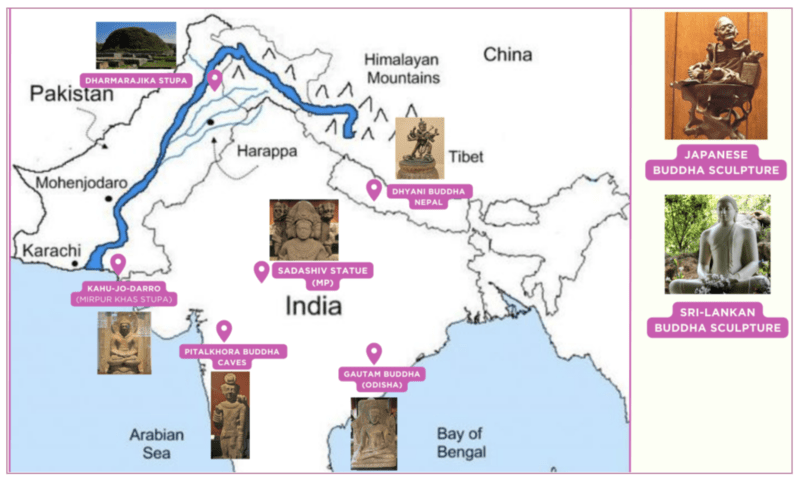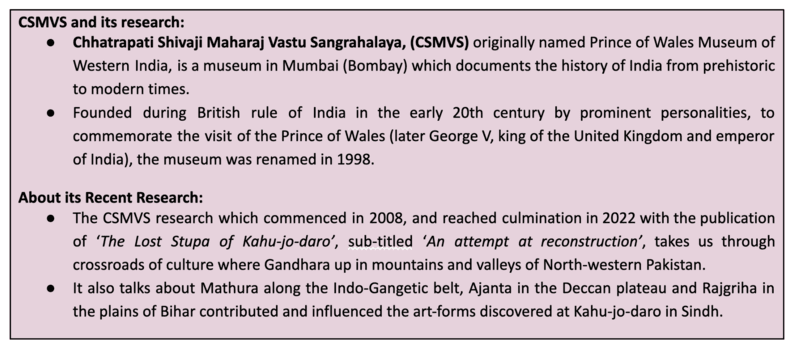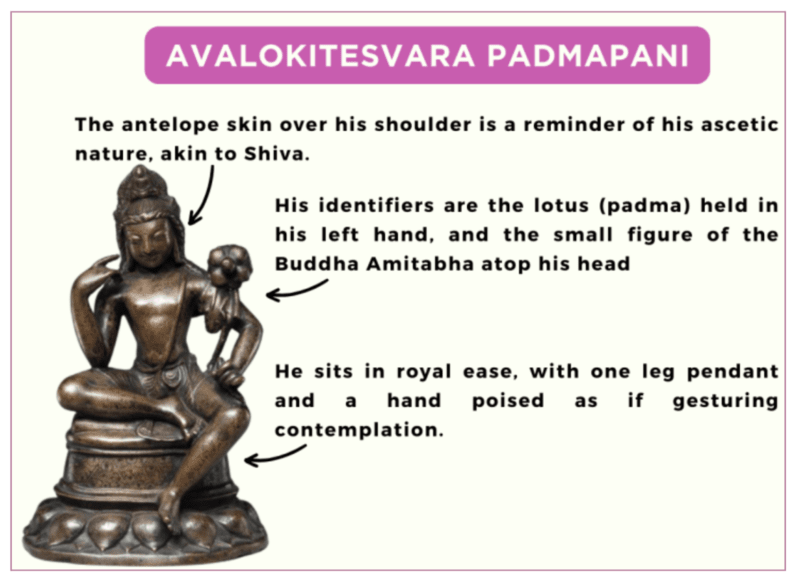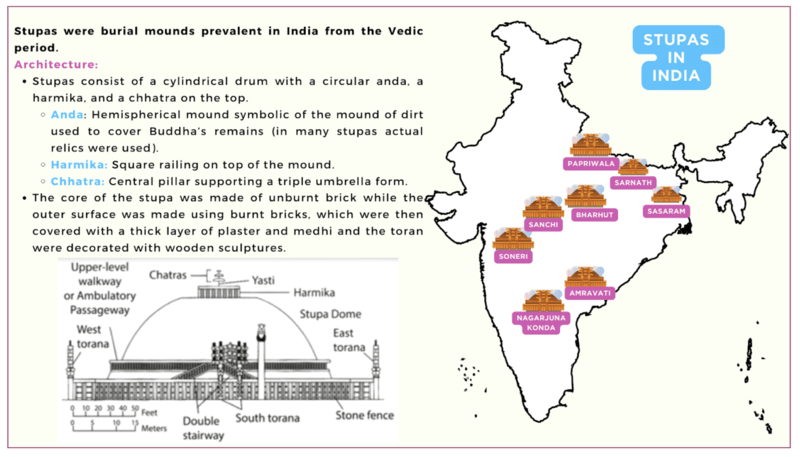Crossroads of Culture
“A concerted effort to preserve our heritage is a vital link to our cultural, educational, aesthetic, inspirational and economic legacies - all of the things that quite literally make us who we are." - Steve Berry
Relevance: GS I (Art and Culture)
- Prelims: Indus Valley Civilization;
- Mains: Protection and Conservation of Culture and Heritage;
Why in the News?
The Chhatrapati Shivaji Maharaj Vastu Sangrahalaya (CSMVS), developed the collection about the full-length study of Buddhist architecture and the discovery of a ‘lost stupa’ at Kahu-jo-daro in Sindh, Pakistan.
Buddhism in its global character:
- Buddhism was thought as growing, radiating, and becoming a major religion from the east: with its centres in today’s Bihar, Uttar Pradesh, Odisha, and Andhra Pradesh; and later parts of Madhya Pradesh and Gujarat, with the movement to Tibet, Mongolia, China, and Sri Lanka giving Buddhism its global character.
- Referring to the present era of globalization, it is very important for global citizens, especially the young, to understand that the Indian sub-continent was always part of the globalized world.

- Kahu-jo-daro in Mirpurkhas, is not an isolated instance of artistic activity in the area. There are several links of the ruined Buddhist stupa with Takshashila, the chief city in the eastern region of Gandhara.
- Sabyasachi Mukherjee in his book, ‘The Lost Stupa’ explained the great river ‘Sindhu’, which is the Sanskrit name of river Indus, passed through the valley from the north to the south and acted as an important trade, religious and cultural connection for the Indus Valley, Punjab and the Gandhara region.
- This riverine connection, water-highways of the ancient world, had a continuing and deep impact on Sindh’s social, cultural, and economic history, providing crossroads and bridges for people of the region. Buddhism as a religion and way of life found adherents in Sindh.

KAHU-JO-DARO STUPA AT MIRPURKHAS:

Its Discovery story:
- In 1859, General John Jacob, another senior official, described the site as the remains of a brick platform and even excavated the upper part of the mound.
- Findings: An earthenware pot filled with mud and pieces of amethyst and crystal; the whereabouts of this pot or vase are unknown.
- In 1909 the stupa story began with British archaeologist Sir Henry Cousens, who was the first to have excavated the Kahu-jo-daro site.
- Originally, the Kahu-jo-daro stupa was decorated with 11 terracotta relief panels of seated Buddhas in the niches of the four faces of the platform. Each of the north, east, and south faces had three large panels on either side of the entrance to the stupa from the west side
What does artistic history say?
- Kahu-jo-daro, as ‘The Lost Stupa’ belonged to a much earlier era; it could have been a reconstruction of a ruined stupa erected under Emperor Asoka’s orders in the 3rd century BCE.
- Long ago, there existed cultural ties between Rajgriha in Bihar and Roruha in Pakistan.
- The terracotta discoveries here include intricately and elegantly carved Buddha images as well as several Hindu works of art such as Brahma. Its artwork is more complex and resembles that found at ancient sites such as Ajanta and Bhitargaon in India.
- One can easily imagine the magnificent scene around the stupa in the valley of ‘Kahu-jo- daro’ and the main stupa with its majestic harmika stood nearly 20 meters tall, its towering presence inspiring devotees and pilgrims approaching from over a long distance.
- The various terracotta artworks found here have been variously dated between the 6th and 10th centuries and include a remarkable 7th-century painted image of Avalokiteshvara Padmapani.

- Understanding facets and religious inspiration:
- The artworks observed at this site are tangentially similar to the Sarnath and Mathura arts in India.
- Clay slates that contain the Buddhist formula “Ye Dharma Hetu” are inspired by the 7th-8th century script that was discovered.
- However, during the recent research, it was an immensely difficult task and an understatement as the project began without inscriptions or literary evidence.
- It highlights the riverine culture, urban centres, trading towns, besides significance of religious places where people prayed, contributed their earnings, keeping places of worship alive through centuries.
- The artworks observed at this site are tangentially similar to the Sarnath and Mathura arts in India.
- Other findings:
- 297 moulded bricks and architectural fragments. (uniform size and shape)
- Five large seated Buddha images in high relief; and a smaller figure within a niche of a standing male figure holding a flower in relief.
- Two roundels and Rectangular bricks depicting the image of Kubera.
- A few rectangular bricks bearing the probable image of Jambala.
- A large number of sun-dried clay tablets and fragments of a stone depicting a Jataka tale.
Conclusion:
The Lost Stupa is about finding and building everlasting peace. In today’s time of peace and prosperity, preservation of cultural heritage has to become a top priority for UNESCO, governments of different countries and civil society too. The power of culture can change the world as it unites people, countries, religions, and customs. It works as a healing tool in our broken societies.
BEYOND EDITORIAL:
Rajgriha (Bihar) – City of Kings
- It was the capital of the Magdha Mahajanapada that is believed to have eventually evolved into the pan- Indian Mauryan Empire.
- The city finds its mention in Mahabharata and continues to become an important landmark in Buddhist and Jaina literature. It is also home to the historic and contemporary Nalanda University.
- It’s Significance:
-
- The city is fortified by the hills of the Barabar range, providing natural protection.
- Interestingly, the Barabar range is home to the four oldest rock-cut caves of India believed to have been built during the Mauryan empire.
- The city is also a terminal point in the Dakshinapatha, the trade route connecting the Gangetic planes to the Deccan.
- The first Buddhist council was held at Rajgiriha to compile and commemorate the teachings of Buddha, after a year of his passing.
- This tradition of Buddhist councils was continued in the Mauryan empire with the 3rd Buddhist council being taken place in Patliputra under the patronage of Ashoka.
Emperor Ashoka and his contribution towards Buddhism:
- The Great Mauryan ruler Ashoka embraced Buddhism and the immense Buddhist missionary activities that followed during his rule paved the way for the development of Mauryan sculptural and architectural styles.
- Edict 13 on the Edicts of Ashoka Rock Inscriptions reflect the great remorse the king felt after observing the destruction of Kalinga. King Ashoka patronized the shraman tradition in the third century BCE.
- After the Kalinga War and Ashoka’s conversion, the Empire experienced nearly half a century of peace and security (Under ‘Dhamma’ which means dharma). He contributed in following ways:
-
- Supporting and earning the approval of the Buddhist sangha.
- Funded the construction of stupas, and supported the ordination of monks in their kingdom.
- Close association in many Southeast Asian countries between the monarchy and the religious hierarchy, an association that can still be seen today in the state-supported Buddhism of Thailand.
- He built a number of stupas, Sangharama, viharas, chaitya, and residences for Buddhist monks all over South Asia and Central Asia. According to the Ashokavadana, he ordered the construction of 84,000 stupas to house the Buddha's relics.
- In the Aryamanjusrimulakalpa, Ashoka takes offerings to each of these stupas, traveling in a chariot adorned with precious metals. He gave donations to viharas and mathas. He sent his only daughter, Sanghamitra, and son, Mahindra, to spread Buddhism in Sri Lanka (then known as Tamraparni).
Chandragupta Maurya’s embrace of Jainism increased social and religious renewal and reform across his society, while Ashoka’s embrace of Buddhism has been said to have been the foundation of the reign of social and political peace and non-violence across all of India.

Prelims PYQs
Q. In which of the following relief sculpture inscriptions, is 'Ranyo Ashoka' (King Ashoka) mentioned along with the stone portrait of Ashoka? (2019)
- Kanganahalli
- Sanchi
- Shahbazgarhi
- Sohgaura
Mains PYQs
Q. The ancient civilization in Indian sub continent differed from those of Egypt , Mesopotamia and Greece in that its culture and traditions have been preserved without breakdown to the present day. Comment (2015)
Q. To what extent has the urban planning and culture of the Indus Valley Civilization provided inputs to the present-day urbanization? Discuss. (2014)


